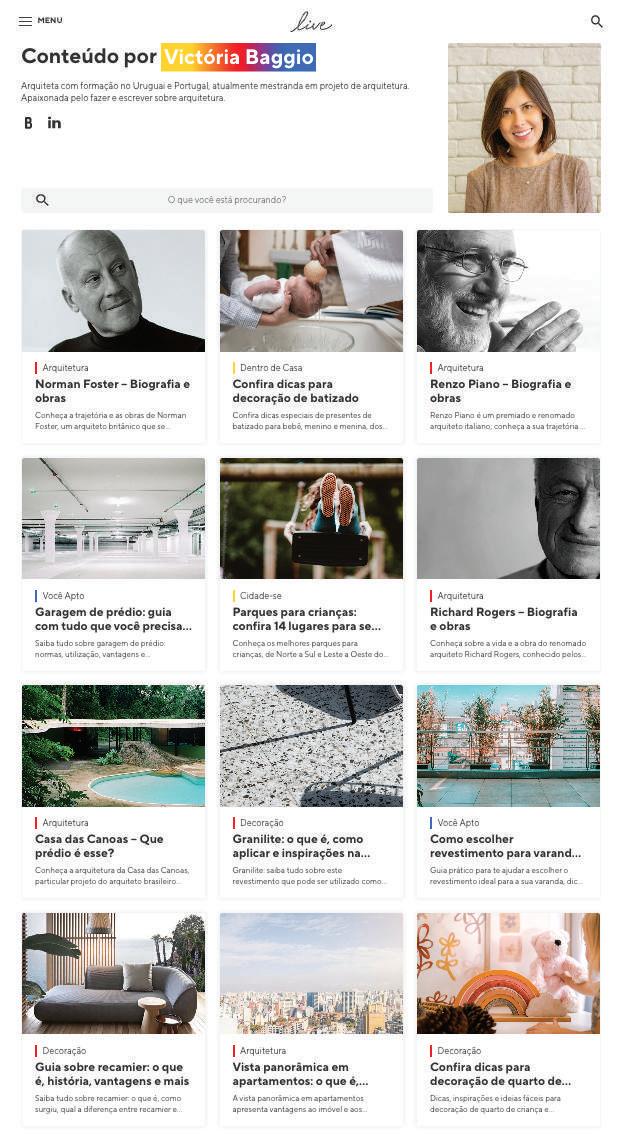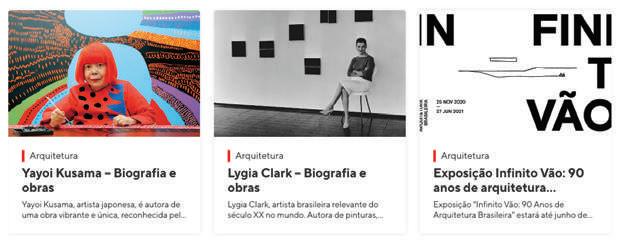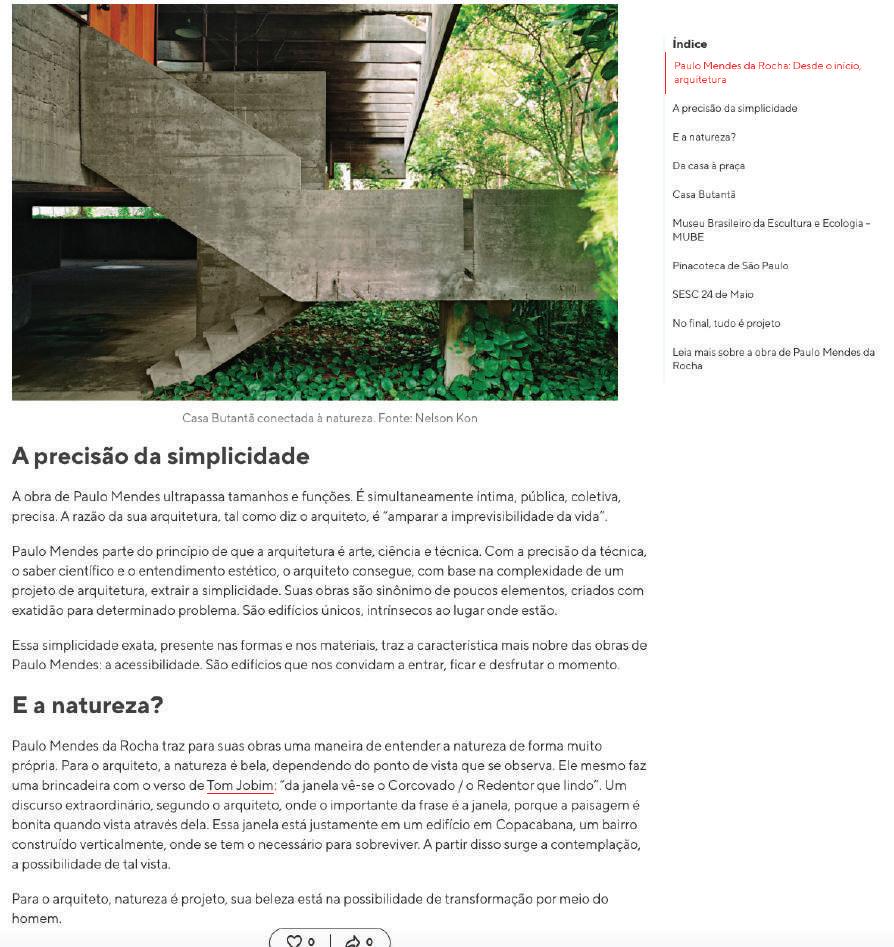
Victória Baggio architect

Birth: 11 . 19 . 1993
Nationality: Italian / Brazilian
E-mail: victoriabaggio19@gmail.com
Phone: +39 3516586218
C o n t e n t
Cover letter
Curriculum Vitae
R e s e a r ch
Cartographies from Childhood Thesis Project FAUP 2023
A r c h i t e c t u r e P r o j e c t s
Primary School Final Project FADU+FAUP 2018 Abbey Museum Competition
Sport Center FADU
P u b l i c a t i o n s
Architecture+ contents Live.apto.vc
Architectural writting Arquitectura y Diseño Magazzine 2016
A r c h i t e c t u r e E d u c a t i o n
Childrens workhops Casa da Arquitectura 2023
Ludic Architecture Workshop FAUP
Architectural project, education in architecture and writing; the three composers of my trajectory and enthusiasm.
Designing architecture is something that motivates me and I have been exercising in different places and scales, from intimate to public scales and urban infrastructure, collaborating in architectural design teams in Uruguay, Brazil and Portugal. In 2020 I had the opportunity to carry out my first project built, a country house in Uruguay.
The relationship between Architecture, Education and Childhood is something that I discovered during college, I fell in love completely and it is where I want to pursue my career as an architect.
In the editorial, writing and publishing field, I found a space for the development of critical and creative thinking.
A c a d e m i c E d u c a t i o n
D e g r e e s
PhD student at Faculdade de Arquitetura da Universidade do Porto, Porto, Portugal (2022-2026)
Graduated in Architecture at Facultad de Arquitectura Diseño y Urbanismo (FADU), Montevideo, Uruguay, 2018 (2011-2018)
A d i t i o n a l C o u r s e s
Montessori Pedagogy Course, International Montessori Institute (2022)
Modern Architecture in São Paulo course, with Gabriel Kogan, São Paulo, Brazil (2018)
Internacional Course IUCE-UAM in Education and Architecture, Universidad Autónoma de Madrid, Madrid, Spain (2017)
Academic exchange at Faculdade de Arquitetura da Universidade do Porto, Porto, Portugal (2016-2017)
A c a d e m i c E x p e r i e n c e
Assistant professor at Arquitetura e Cinema discipline, Faculdade de Arquitetura da Universidade de São Paulo, São Paulo, Brazil (2020)
Workshop assistant at Ludic Architecture, Faculdade de Arquitetura da Universidade do Porto, Porto, Portugal (2017)
Assistant professor at Taller Berio project studio, FADU, Montevideo, Uruguay (2014-2017)
Assistant designer in Modernidad Infiltrada Thesis, by the architect Elena Roland, Master Degree FADU, Montevideo, Uruguay (2015)
W o r k s h o p s / S e m i n a r i e s
Rede EPA (Educação para Arquitetura) encounters, Portugal (2022, 2023)
Workshop “Ciência e Política Pública: como conseguir pontes?”, Faculdade de Arquitectura da Universidade do Porto, Portugal (2023)
Acervos de Arquitetura e Urbanismo Seminary, São Paulo, Brazil (2020)
Arquitetura em Diálogo: Portugal e Brasil seminary, Casa da Arquitectura, Matosinhos, Portugal (2019)
Workshop O local do projeto: Técnicas de investigação e interpretação, Fernando Viégas, UNA Arquitetos, São Paulo, Brazil (2017)
Forum Future Is Now, Norman Foster Fundation, Madrid, Spain (2017)
Architect educator at Casa da Arquitectura Education Service, Matosinhos, Portugal (since 2022)
Member of Rede EPA (Education for Architecture), Portugal (since 2022)
Editor of Curso de Estudos Avançados em Território, Faculdade de Arquitetura da Universidade do Porto, Porto, Portugal (2022-2023)
E d i t o r i a l
Editor and writer of architecture publication for Arkitito, São Paulo, Brazil (2021-2022)
Writer and content creator for Live website (https://live.apto.vc), São Paulo, Brazil (2020-2023)
Writer at Entrevista ao arquiteto Álvaro Siza, Contrastre 5 Magazine, São Paulo, Brazil (2018)
Writer at Arquitectura y Diseño Magazine, Montevideo, Uruguay (2016)
Architect at Benedita(s), Porto, Portugal (2022)
Architect at Estudio Módulo, São Paulo, Brazil (2019)
Architect at Costa Lima Arquitectos, Porto, Portugal (2019)
Architect at Flume, special colaboration in exhibition design for Dust to Dust: Redesigning urban life in healthy soils, Sainsbury Centre for Visual Arts, São Paulo, Brazil (2018)
Architect at 23 Sul Arquitetura, São Paulo, Brazil (2018)
Illustrator advanced Photoshop advanced InDesign intermediate WordPress advanced
AutoCad advanced Sketchup advanced Revit basic
Portuguese native Spanish fluent English advanced (C1) Italian basic (B1)
Childhood Cartographies: Inclusion through play
Thesis Project
Faculdade de Arquitectura da Universidade do Porto, Portugal 2023
Abstract
Most children live in urban areas (UNICEF, 2012). The contemporary reality of urbanization (UN-Habitat, 2022) reveals the concentration and population growth alongside increasing social inequalities, reflected in social and spatial stratification (Sarmento, 2018). In Brazil, 63% of children live in poverty (UNICEF, 2023). This reality highlights the urgency to develop strategies that prioritize the place of childhood in the territory, where public spaces for play reveal an essential role, capable of regenerating degraded areas and bringing society closer together.
This research aims to contribute to the recognition of the educational, sensitive, and collective territory (Pinheiro, 2019). By understanding the territory inhabited by children in the favelas of Rio de Janeiro, Brazil, using play as an educational instrument with the potential for incorporation into public policies, planning, and urban design, the goal is to value children and make them visible as active citizens.
The theoretical-practical approach of this research, focusing on the case study of the Complexo da Maré in Rio de Janeiro, seeks to develop participatory mechanisms of reading and action to promote inclusive territories. The methodology, consisting of stages – recognizing, approaching, mapping, and constructing – utilizes cartography as a foundational tool for recognizing, identifying, valuing, and transforming public spaces for social interaction in the favela.
Perceiving children as recipients and interpreters of public space construction (Sarmento & Tomás, 2007), promoting reflection and action on this subject means fostering humanization among the inhabitants of the territories and their actors (Friedmann, 2021), in a quest for an environment that favors movement, discovery, and encounters (Vidigal, 2021).
Through collective reflection, while recognizing the potential of favelas towards more equal and inclusive societies and cities (Ribeiro, 2019), this research aims to contribute to the visibility of thinking and acting in contemporary urbanity through and with children, encouraging research and practices concerning the multiple childhoods that inhabit the contemporary territory.
Keywords:
Childhood; favela; play; participation; public space; cartography; Maré.
Primary School
Porto, Portugal
Final Project
Faculdade de Arquitectura da Universidade do Porto, Portugal + Facultad de Arquitectura Diseño y Urbanismo, Montevideo, Uruguay
2017-2018
This project, with the program of a Primary School in Porto, Portugal, begins with the intention of creating a space totally dedicated to children, understanding the space as an exceptional educational tool. A school as a home for collective learning. A unique, continuous, flexible, articulated, transparent space, in constantly contact with the natural and urban exterior. A place that shelts, while allows freedom. A space as defined by a child:
Space: “Limited place between two objetcs”.
The project concept arises from the previous definition. From the presence of objects, the continuous space is limited, possibly fractional, without making the fluency impossible. These equipments appear as the only massive elements of the building, as solid cores that serve the void, allowing its colonization.




Abbey Museum
Siena, Italy
Architecture Competition
2020
team: Victoria Baggio and Renan Prado
Museum is a place of knowledge dissemination and social reflection, through the conservation and exhibition of historical objects. It is proposed for the Abbey Museum the expansion of this meaning, being able to internalize and expose the context in which it is inserted, generating reflections towards the Tuscan landscape and the Abbey architecture.
The project design is developed through the existing elements in the surroundings, which provide abstract lines, creating boundaries for the insertion of a new volume in the context. Thus, the primordial volume of the building is generated, a massive rectangular prism, precisely arranged in the monastic complex. Then, a second derivation of abstract lines, derived from the relationship between the existing volumes, are used as guides for excavations in the prism, generating exterior patios. The resulting shape is made up of four smaller prisms joined by a centrality. This
center is also excavated in order to make it an organizing element for access, routes and program distribution.
The project is defined by mutual framing: At the same time that the surrounding area delimits the implantation of the Museum, this one, through specific openings, determines views between the interior and exterior.
Faced with an architectural context characterized by strong historical and symbolic meaning and the way in which the building's volume was developed, the Museum proposes a materiality of opaque and white surfaces, which emphasizes the geometric relationship between the new and the existing.






Peace Pavilion
Sedhiou, Senegal
Kaira Looro Architecture Competition
2019
team: Victoria Baggio and Renan Prado
For The Peace Pavilion, our desire is to conceive an architecture capable to turn people's eyes to land and its multiple aspects. Land as a natural element, where cycle of life happens. Land as the element transformed by humans, where communities are developed. Land as tribute to war victims and reminder of the present. At the same time, we believe the Peace Pavilion has to be a public space, a place of meeting for every kind of person. For that reason, the Pavilion is a light wide open space b uilt around a monolithic opaque solid volume.
area. Beyond that, the Monolith is the receptor, treater and container of collected rainwater.
The Pavilion arrangement suggests a promenade to the visi tors, where they go from anxiety to contemplation, from vibrance to silence, from a social behaviour to a condition of mediation.
E d u c a ç ã o
Estudo Universitário: Facultad de Arquitectura Diseño y Urbanismo (FADU), Montevidéu, Uuruguai (2011-2018)
While the Exhibition and the Contemplation areas are open to the horizon, the transition between them is filtered by the Monolith, which hosts the Spreading Awareness area and its documental exhibition. It generates a transformative space that frames a serie of external environment aspects to create the best atmosphere possible for each
Faculdade de Arquitetura Universidade do Porto, Porto, Portugal (intercambio academico setembro 2016 - julho 2017)
The main entrance of the Pavilion is the Exhibition Area, which is the widest one. It is visible from the city to attract people to come over and it is capable to host social meetings. Its aspects guarantees a more informal and accessible approach to the artistic works exhibit ed on it. The room is involved by pivoting panels and the Monolith.
Estudos Secundarios: Colégio Anchieta, Porto Alegre, Brasil
P r o g r a m a s D i g i t a i s
AutoCad
Sketchup
Photoshop
Illustrator
Corel Draw
I d i o m a s
Português
Espanhol
Inglês
disciplina “Estudos Críticos de Alavaro Siza Faculdade de Arquitetura da Universidade do Porto, Porto, Portugal (fevereiro 2017)
Trabalho de investigação
“Por uma cidade menos partida e mais inteira Faculdade de Arquitetura da Universidade do Porto, Porto, Portugal (dezembro 2016)
Monitoria no ateliê de projeto Taller Berio, FADU ( 2015-2017)
Colaboradora na tese “Modernidad Infiltrada , arquiteta Elena Roland, Diploma de Posgrado en Investigación I+P, FADU (agosto-dezembro 2015)
Estágio no ateliê de projeto Taller Berio entrevistas a arquitetos professores do Taller FADU (2015)
E x p e r i ê n c i a P r o f i s s i o n a l
Escritora na Revista Arquitectura y Diseño
(maio 2017)

Curso de Educação Permanente de Posgrado: “Panoramas Interiores arquitectos Paolo Giardiello y Marella Santangelo (Itália), FADU, Mondevidéu, Uruguai (maio 2015)
Bienal Iberoamericana de Arquitectura y Urbanismo, Rosario, Argentina (outubro 2014)
Seminário Montevideo + Passages, FADU , Mondevidéu, Uruguai (setembro 2014)
Seminário Bicentenario: “Visiones para Montevideo Taller Berio, FADU, Mondevidéu, Uruguai (março 2014)
Workshop “Productora , arquitetos Carlos Bedoy y Abel Perles (México), Taller Scheps, FADU, Mondevidéu, Uruguai (agosto 2013)
Seminário “50 UY Taller Scheps, FADU, Mondevidéu, Uruguai (agosto 2013)


Eco Urban Systems
Villa Lugano, Buenos Aires, Argentina
Project IV, Taller Perdomo, FADU
2015
team: Victoria Baggio and Juan Pablo Lopez
Eco Sistemas Urbanos
A sector is assumed for an urban scale project. This consists of a court of approximately 100x100 square meters located at Villa Lugano, in Buenos Aires, Argentina.

Villa Lugano, Buenos Aires, Argentina
permeability of each band, and, through its interference, the maximum number of programmatic mutations.
Curso de Projeto IV, Taller Perdomo, FADU
Based on a conceptual reference coming from the OMA team project, for the Parc de la Villette, the project materializes the creation of a metaphorical metropolis that embodies the culture of chaos. Where a park supposes an unexpected encounter between music, sport, technology and nature without a precise limit.
The terrain is subdivided into a series of parallel east-west bands that organize the fundamental program areas. This band strategy creates a maximum longitude of borders between the maximum number of programmatic components, guaranteeing, therefore, the maximum
It is the thought of a diverse city, understanding the immediate coexistence of different realities and experiences as a starting point for the proposal. A city diverse from its architecture, spaces, events and people. The city as something natural, is therefore called “Urban Eco Systems” to those extracts of soil where all these experiences are consolidated. Nature is contained in a rigid space, defined by an abstract system, if it works with a series of manufactured landscapes, generating its artificialization and exaltation. The dialogue between nature and artifice is reversed.
2015
uma quadra de aproximadamente 100x100 metros quadrados localizada na Villa Lugano, em Buenos Aires, Argentina.
A partir de uma referencia conceitunal beseada no projeto da equipe OMA, para o Parc de la Villette, no projeto é materializada a criação de uma metrópolis metafórica que personifica a cultura do caos. Onde um parque supõe um encontro inesperado entre música, esporte, tecnología e natureza sem um limite preciso.


O terreno se subdivide em uma série de bandas paralelas este-oeste que organizam as áreas programáticas fundamentais. Esta estratégia de bandas cria uma mpaxima longitude de fronteiras entre o máximo numero de
de cada banda, e, através de sua interferencia, o máximo número de mutações programáticas.
Se pensa uma cidade diversa, entendo a coexistênica imediata de diferentes realidades e experiências como ponto de partida para a proposta. Uma cidade diversa desde sua arquitetura, espaços, acontencimentos e pessoas. A cidade como algo natural, se chama portanto Eco Sistemas Urbanos a aqueles estratos de sólo onde se consolidam todas estas vivências. A natureza é contida em um espaço rígido, definido por um sistema abstrato, se trabalha com uma série de paisagens manufaturados, gerando uma artificializaçao e exaltaçao da mesma. Se inverte o diálogo entre natureza e artifício.




Sports Center
Montevideo, Uruguay
Project III, Taller Berio, FADU
2014
This project arises from the idea of a massif on the green. The artificial, heavy, which, in contrast to the natural park where it is located, becomes permeable, opens up, allowing the green to enter the stone, and coexist.
The green penetrates the built mass, creating relations with the place where it is located and allows a bath of light to the building. These places of relationship conform as natural patios, with different colors and uses, creating interiors with different qualities in contact with the park, allowing the composition of various atmospheres and sensations in the same building.













